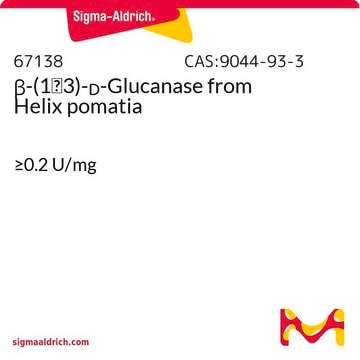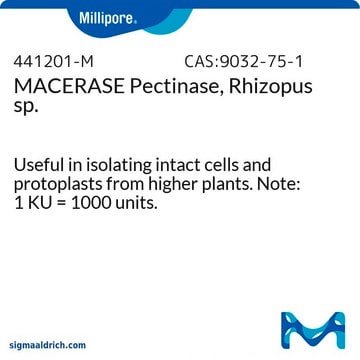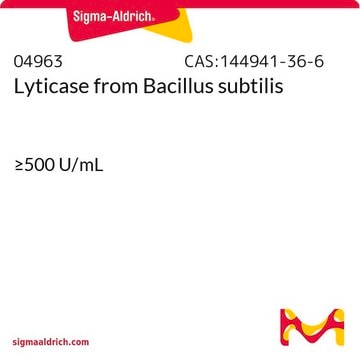L3768
Lysing Enzymes from Aspergillus sp.
powder
Sinónimos:
Cellulase, Lysing Enzymes, Pectinase
Iniciar sesiónpara Ver la Fijación de precios por contrato y de la organización
About This Item
Código UNSPSC:
12352204
NACRES:
NA.54
Productos recomendados
origen biológico
Aspergillus niger
Formulario
powder
técnicas
cell based assay: suitable
color
brown
idoneidad
suitable for cell lysis
aplicaciones
cell analysis
temp. de almacenamiento
2-8°C
Descripción general
Lysing enzymes are also known as lytic enzymes or cell wall lytic enzymes.
Aplicación
Lysing Enzymes from Aspergillus sp. has been used to digest the cell walls to create pulse-field gel plugs.
Lysing Enzymes from Aspergillus sp. has been used:
- to digest the cell wall of Schizosaccharomyces pombe
- to lyse the mycelium cell wall of Trichoderma harzianum
Acciones bioquímicas o fisiológicas
Lysing enzymes are a group of enzymes that can break down the cell walls of microorganisms. These enzymes play a crucial role in various biological processes, including cell lysis, tissue dissociation, and protein extraction. Lysing enzymes are commonly used in research, biotechnology, and clinical applications. They are especially useful in DNA extraction, where they help to release genetic material from cells by breaking down the cell walls. This enables efficient isolation and purification of DNA for downstream analyses. Cellulases are a class of enzymes that degrade cellulose, a major component of plant cell walls, into simpler sugars. These sugars can be utilized as raw materials to produce biofuels, biobased chemicals, plastics, and various other materials. Pectinases are a group of enzymes that hydrolyze pectic substances found in microorganisms and higher plants. They can break down the pectin-containing compounds synthesized by plants and microbes.
Calidad
Contains pectinase and cellulase activities.
Código de clase de almacenamiento
11 - Combustible Solids
Clase de riesgo para el agua (WGK)
WGK 3
Punto de inflamabilidad (°F)
Not applicable
Punto de inflamabilidad (°C)
Not applicable
Elija entre una de las versiones más recientes:
¿Ya tiene este producto?
Encuentre la documentación para los productos que ha comprado recientemente en la Biblioteca de documentos.
Los clientes también vieron
Pectinase from Microorganisms and Its Industrial Applications
Haile S and Ayele A
TheScientificWorldJournal (2022)
Unleashing the Promise of Biotechnology to Help Heal, Fuel, and Feed the World
Greenwood JC
Journal of biological and chemical chronicles (2014)
New strains obtained after UV treatment and protoplast fusion of native Trichoderma harzianum: their biocontrol activity on Pyrenochaeta lycopersici
Besoain X A, et al.
Electronic journal of Biotechnology, 10(4), 604-617 (2007)
Translesion synthesis polymerases contribute to meiotic chromosome segregation and cohesin dynamics in Schizosaccharomycespombe
Mastro TL, et al.
Journal of Cell Science (2020)
Tara L Mastro et al.
Journal of cell science, 133(10) (2020-04-23)
Translesion synthesis polymerases (TLSPs) are non-essential error-prone enzymes that ensure cell survival by facilitating DNA replication in the presence of DNA damage. In addition to their role in bypassing lesions, TLSPs have been implicated in meiotic double-strand break repair in
Nuestro equipo de científicos tiene experiencia en todas las áreas de investigación: Ciencias de la vida, Ciencia de los materiales, Síntesis química, Cromatografía, Analítica y muchas otras.
Póngase en contacto con el Servicio técnico









